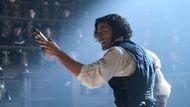Guillermo del Toro's Frankenstein borrows its elements from Mary Shelley's novel, but it doesn't stay confined to its usual creature-feature interpretation. In a Variety interview, the filmmaker mentioned that he doesn't see it as a horror film but as a somber drama with a deeper exploration of familial traumas, aimed at redefining the monsters and humans.
Besides this key thematic focus, Del Toro was also particular about another aspect of his Netflix film.
"It’s extremely important for me to keep the reality of film craft alive. I want real sets. I don’t want digital. I don’t want AI. I don’t want a simulation. I want old-fashioned craftsmanship," said Del Toro.
He continued,
"I want people painting, building, hammering, plastering. I go in and paint props myself. I supervise the construction of the sets. There is an operatic beauty when you build everything by hand. You feel that you are being swept along by the work of hundreds of people."
Guillermo del Toro breaks down his writing and directorial process for Frankenstein

In the age of the growing push of AI-backed regurgitation and CGI-laden storytelling, Guillermo Del Toro wanted to keep things rooted in reality. That's why, for Frankenstein, he focused on building actual sets as opposed to digitally constructing them. He embraced film craft with practical effects for a distinctive look and feel as opposed to the digital alternatives.
It's not only Del Toro who appreciates the value of practical effects. James Gunn's Superman featured an actual set of the Fortress of Solitude instead of a CGI one. Even Michael Shanks's Together presented its gruesome body horror with a clear emphasis on practical effects, despite his background as a VFX artist.
Coming back to Del Toro's Frankenstein, it won't be a standard horror film seeking thrills through the monster's grotesque appearance as a plot device.
“The usual discourse of Frankenstein has to do with science gone awry. But for me, it’s about the human spirit. It’s not a cautionary tale: It’s about forgiveness, understanding, and the importance of listening to each other," said Del Toro.
As said before, this adaptation will dig deeper into the psychological aspects to reinterpret monsters and humans, more specifically, their humanness of monstrosity.
“Ridiculous as it may sound, I see it as a biography of these characters,” said Del Toro.
Del Toro's film stars Oscar Isaac as the brilliant but egotistical scientist Victor, while Mia Goth is set to play both his mother and his potential love interest, offering a Freudian touch to the story. Game of Thrones star Charles Dance plays Victor's authoritative father, who is behind the deeply flawed person Victor ends up being.

Speaking about the monster, Del Toro aims to explore his innocence as opposed to his lanky and patchy appearance. He wanted to offer a look at his heart, as he gets shunned and abused for things he cannot control. That's also why he cast Jacob Elordi for this role.
"I saw 'Saltburn,' and I loved his innocence and openness. He plays the victim of a Tom Ripley-type of character, and I thought he played it with a lot of range. His character was also capable of being high-class and cruel. Jacob’s eyes are so full of humanity. I cast him because of his eyes," said Del Toro.
Besides Guillermo del Toro, Mary Shelley's text will also serve as an inspiration for Maggie Gyllenhaal's upcoming film, The Bride!, where Jessie Buckley plays Frankenstein's bride, while Christian Bale stars as Frankenstein's monster.
There's also Frankenstein in Romania, written and directed by Radu Jude, where Sebastian Stan is poised to play both Victor and the Monster.
Guillermo del Toro's Frankenstein is scheduled for a limited theatrical release on October 17, for three weeks, before premiering on Netflix to stream online.
Love movies? Try our Box Office Game and Movie Grid Game to test your film knowledge and have some fun!
